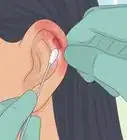This article was co-authored by Sasha Blue. Sasha Blue is a Professional Body Piercer and the Owner of 13 Bats Tattoo and Piercing Studio in the San Francisco Bay Area. Sasha has over 20 years of professional body piercing experience, starting with her apprenticeship in 1997. She is licensed with the County of San Francisco in California.
wikiHow marks an article as reader-approved once it receives enough positive feedback. In this case, 99% of readers who voted found the article helpful, earning it our reader-approved status.
This article has been viewed 621,916 times.
Cartilage piercings are a fun fashion statement but they require a lot of care while they heal. Be gentle with your piercing and always wash your hands before touching it. Clean the area twice a day with a salt water solution and remove loosened crust formations. Check the piercing for signs of infection and avoid the temptation to twist or play with it!
Steps
Cleaning the Piercing Regularly
-
1Wash your hands. Always wash your hands thoroughly with an antibacterial soap before handling a cartilage piercing. Touching the pierced area can introduce bacteria or other pathogens to the body.[1]
-
2Soak your piercing. Dissolve 1/4 teaspoon of sea salt in an egg cup of warm water. Place the pierced part of your ear in the water. Remove it after 2-3 minutes of soaking.[2]Advertisement
-
3Gently remove loosened buildup. Wipe away any buildup of discharge that may have loosened around the piercing. Wet a piece of gauze and gently dab at the debris to remove it. If the crusted formation does not remove easily, leave it alone and do not use force to loosen it.[3]
- Always avoid using cotton balls or Q-tips when cleaning your cartilage piercing, as they may leave behind lint. They may also get caught on the piercing itself, which could cause injury to your ear.
-
4Dry the pierced area. Gently dab the pierced area dry with a paper towel. Avoid using a shared towel, which may spread bacteria and cause an infection. Don't rub the piercing, which could aggravate it while it heals.[4]
Keeping the Piercing Clean
-
1Avoid playing with the piercing. While it is healing, avoid handling your cartilage piercing for any reason other than cleaning it. Turning or twisting the jewelry could cause an infection. The piercing should only be touched with freshly washed hands.[5] [6]
- It might also help to sleep on your back instead of your side.[7]
-
2Make sure that your clothing and sheets are clean. To avoid infection, make sure that your clothing and sheets are clean. During the healing process, clothing that may touch your ear (e.g. a hooded sweatshirt) should be washed after each occasion that you wear it. Make sure that bed sheets (pillow cases in particular) are laundered at least once a week.[8]
-
3Do not use harsh chemicals on the site of the piercing. Avoid using rubbing alcohol or peroxide on your piercing as they can be very drying and damage your skin. Antibacterial soaps and moisturizing bar soaps may leave behind a residue that might contribute to an infection or longer time to heal.[9]
Checking the Piercing for Infection
-
1Keep an eye on the color of the piercing site. It's normal for the skin around your piercing to be red for the first few days after it is pierced, but redness after 3-4 days is a sign of possible infection. Similarly, changes in color of the skin around the piercing (e.g., to a yellowish tint) can indicate that it is infected. Check the color of your piercing site twice a day in the mirror, preferably before cleaning it.[10]
-
2Look for green or yellow pus. During the healing process, a slight, white discharge is normal. If you see pus with a yellow or green tinge, your piercing is probably infected. Check your ear for pus before cleaning the piercing, given that you might wash away traces of discharge.[11]
-
3Check for bleeding or swelling. Prolonged bleeding of the piercing site is not normal and is a cause for concern. Similarly, swelling that does not go down after 3-4 days may be a sign of infection. Check the pierced area daily.[12]
-
4Contact a doctor if signs of infection appear. If your piercing develops signs of a bacterial infection, contact your physician or visit a walk-in clinic immediately. A doctor may prescribe antibiotics or an anti-bacterial ointment to treat the problem. Left untreated, a cartilage piercing infection may lead to an abscess, which usually requires surgery and may leave ears deformed.[13]
Expert Q&A
-
QuestionHow can I make my cartilage piercing heal faster?
 Sasha BlueSasha Blue is a Professional Body Piercer and the Owner of 13 Bats Tattoo and Piercing Studio in the San Francisco Bay Area. Sasha has over 20 years of professional body piercing experience, starting with her apprenticeship in 1997. She is licensed with the County of San Francisco in California.
Sasha BlueSasha Blue is a Professional Body Piercer and the Owner of 13 Bats Tattoo and Piercing Studio in the San Francisco Bay Area. Sasha has over 20 years of professional body piercing experience, starting with her apprenticeship in 1997. She is licensed with the County of San Francisco in California.
Professional Body Piercer Avoid touching and irritating the piercing as much as possible. Also, steer clear of over-the-ear headphones while your piercing heals.
Avoid touching and irritating the piercing as much as possible. Also, steer clear of over-the-ear headphones while your piercing heals. -
QuestionShould I twist my cartilage piercing?
 Sasha BlueSasha Blue is a Professional Body Piercer and the Owner of 13 Bats Tattoo and Piercing Studio in the San Francisco Bay Area. Sasha has over 20 years of professional body piercing experience, starting with her apprenticeship in 1997. She is licensed with the County of San Francisco in California.
Sasha BlueSasha Blue is a Professional Body Piercer and the Owner of 13 Bats Tattoo and Piercing Studio in the San Francisco Bay Area. Sasha has over 20 years of professional body piercing experience, starting with her apprenticeship in 1997. She is licensed with the County of San Francisco in California.
Professional Body Piercer Twisting a piercing is never a good idea. Touching your piercing will only irritate the area and extend your healing time. Plus, you could set yourself up for an infection if you touch the piercing with dirty hands.
Twisting a piercing is never a good idea. Touching your piercing will only irritate the area and extend your healing time. Plus, you could set yourself up for an infection if you touch the piercing with dirty hands. -
QuestionWhat can I do if I have pain when my piercing is touched?
 Community AnswerIt is okay. It may hurt for the first few days, but then it will gradually heal. Your best bet is to try to avoid touching it.
Community AnswerIt is okay. It may hurt for the first few days, but then it will gradually heal. Your best bet is to try to avoid touching it.
References
- ↑ Sasha Blue. Professional Body Piercer. Expert Interview. 25 November 2019.
- ↑ http://www.nhs.uk/Conditions/Body-piercing/Pages/Introduction.aspx
- ↑ http://www.nhs.uk/Conditions/Body-piercing/Pages/Introduction.aspx
- ↑ https://www.nhs.uk/conditions/body-piercing/
- ↑ https://piercingexp.com/aftercare/
- ↑ Sasha Blue. Professional Body Piercer. Expert Interview. 25 November 2019.
- ↑ Sasha Blue. Professional Body Piercer. Expert Interview. 25 November 2019.
- ↑ https://www.nhs.uk/conditions/body-piercing/
- ↑ https://piercingexp.com/aftercare/
About This Article
Before cleaning a cartilage piercing, wash your hands with antibacterial soap. Next dissolve ¼ teaspoon of sea salt in a small cup of warm water, bring the cup up to your ear, and dip the piercing into the water for 2-3 minutes. Then, gently remove any buildup around the piercing with a wet piece of gauze. Finally, dab the piercing dry with a paper towel. After you've cleaned your piercing, keep it clean by not playing with it and making sure any hats, towels, and pillows are clean. Keep reading if you want to learn how to tell if your piercing is infected!
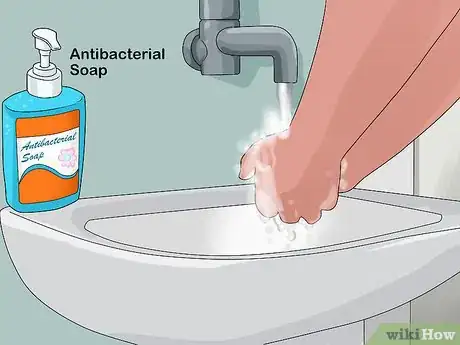

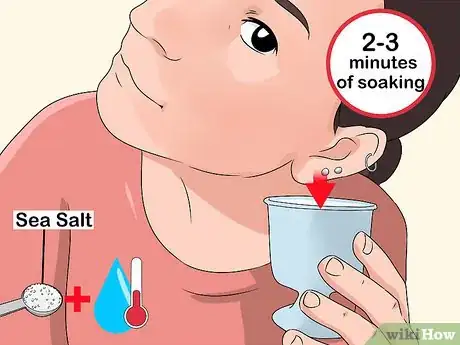

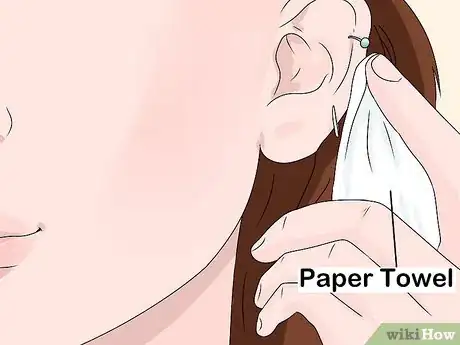
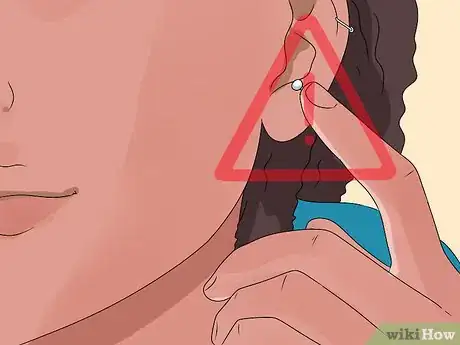

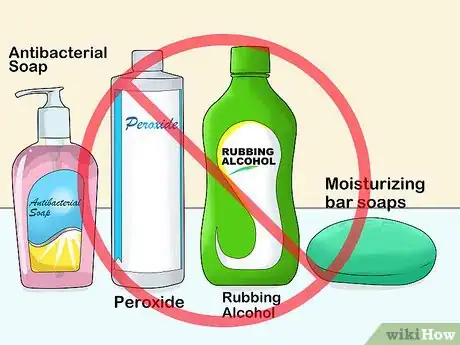
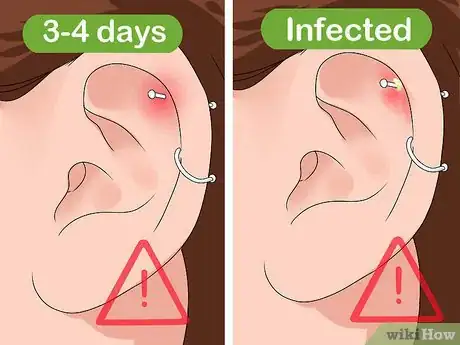
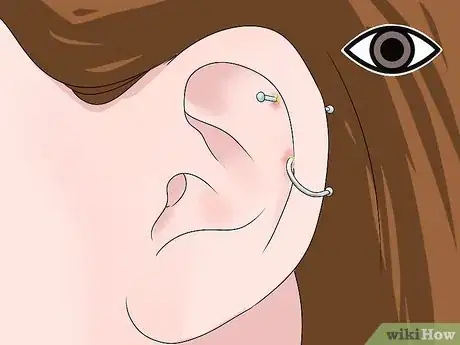
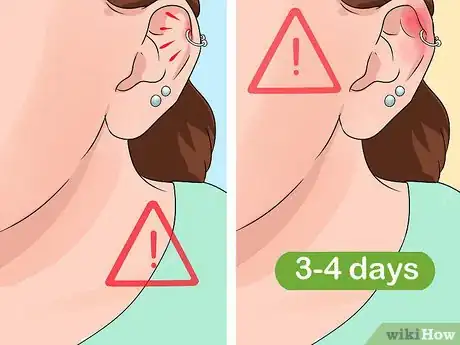

-Piercing-Step-19.webp)
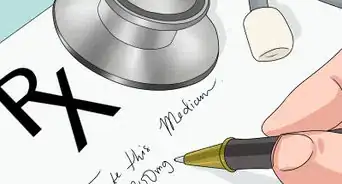
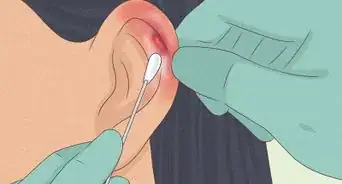

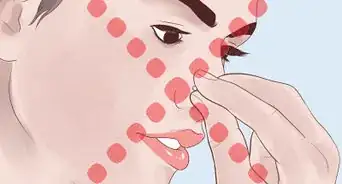
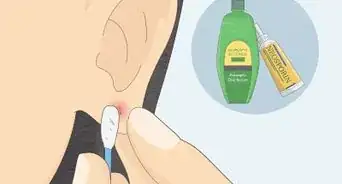
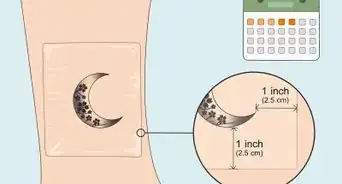
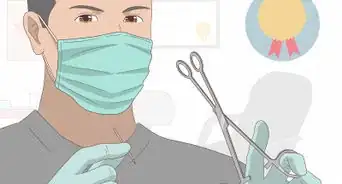



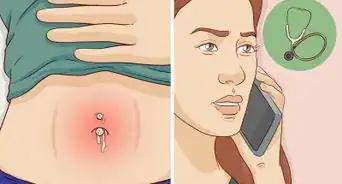









-Piercing-Step-19.webp)

